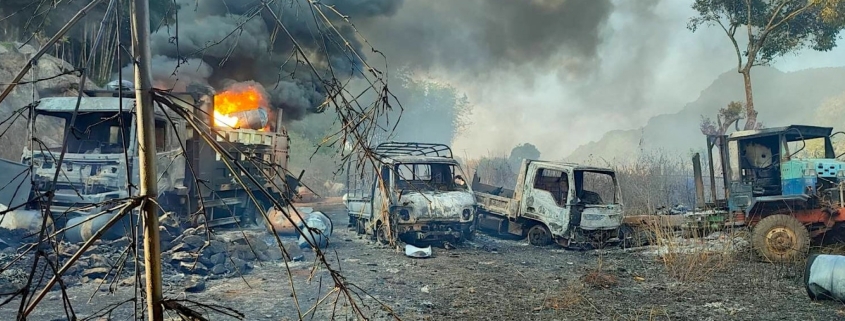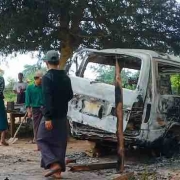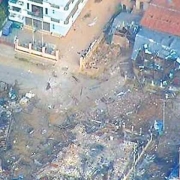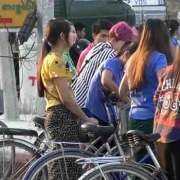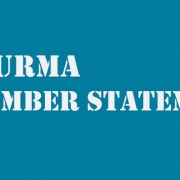At least 35 charred bodies found in Karenni State village on Christmas
The KNDF says that Myanmar junta troops are responsible for the massacre of who they believe to be men, women and children fleeing clashes near a Karenni village
Warning: This report contains disturbing images
The remains of at least 35 charred bodies, including one belonging to a child, were found near a village in eastern Myanmar’s Karenni (Kayah) State early Christmas morning, according to both locals and an anti-junta armed resistance group based in the region.
The bodies were found on eight burned vehicles and five motorbikes near the village of Moso on Saturday. The Karenni Nationalities Defence Force (KNDF) has accused the Myanmar military troops who were present in the area on Friday of committing the crime in question.
The commander of the KNDF’s Brigade 4, who did not want to be named, said that at around 11am on Friday, members of his group saw smoke billowing out of the parked vehicles, but they did not see the burned bodies, as the fire was still blazing.
Due to fears that junta troops may still have been present in the area, the KNDF was only briefly able to visit the area surrounding the trucks that day; it was not until the following morning, when they returned to the scene, that they witnessed the full extent of the massacre.
Moso_village-Burned_vehicles_2.Jpg
 Vehicles torched by the military troops near the village of Moso in Karenni State’s Hpruso Township are seen on December 25 (News Light in Karenni)
Vehicles torched by the military troops near the village of Moso in Karenni State’s Hpruso Township are seen on December 25 (News Light in Karenni)
Among the charred remains were the fingers of a child who the KNDF commander estimated to be younger than five. He noted that KNDF members had previously seen a small vehicle carrying a woman and child pass down the road leading to that area before the fires had started.
“We don’t know exactly how many women, men and children are among those burned. Some became ashes, some others were charred,” the commander told Myanmar Now.
“The [bodies] were no longer recognizable or identifiable when we saw them.”
Supplies found by KNDF members on the vehicles suggested that the victims were locals fleeing clashes in the area.
The commander speculated that the Myanmar army troops may have deliberately set the people in the trucks on fire using gasoline as an accelerant, noting that the vehicles were positioned intentionally next to one another, side by side.
“They [the junta soldiers] are no longer humans. Their crimes are worse than those committed by fascists,” the commander said.
International charity Save the Children said in a statement published on Saturday that two of their staff were returning to their office after carrying out a humanitarian visit in the area when they were “caught up in the incident.” The staff were still missing at the time of reporting.
The organisation wrote that they had received confirmation that their private vehicle had been attacked and burned.
“Save the Children condemns this attack as a breach of International Humanitarian Law,” CEO Inger Ashing said in the statement, adding, “attacks against aid workers cannot be tolerated.”
Around 100 troops from the Myanmar army’s Light Infantry Division 66 made advances from Demoso Township towards Hpruso on Friday, according to the KNDF. The troops then clashed with a joint force belonging to the KNDF and members of the Karenni Army near the village of Moso.
During the military offensive, the army troops beat and arrested villagers and ransacked their property, the KNDF said in a statement on Saturday. The troops also killed four members of the Karenni Border Guard Force (BGF), known as BGF Battalion 1004, who attempted to stop the army troops from terrorising the villagers, the KNDF said.
“[They] arrested four members of the BGF Battalion 1004 and tied them up before executing them by shooting them in the head,” the KNDF statement said.
The KNDF received reports from Moso that some of the village’s residents went missing on Friday and that they would try to confirm the identities of the victims.
“This is an inhumane act,” a spokesperson from the KNDF said. “We would like to express our condolences to the families of those victims whose lives were sacrificed in this incident. Secondly, we will retaliate against the military council in response to this incident.”
Editor’s Note: This article was updated on December 26 to include information from Save the Children’s statement on the incident.
According to the state media reports from the junta’s mouthpiece on Saturday, seven vehicles coming from the village of Kwaing Ngan towards Moso on Friday did not stop when asked to do so by Myanmar army troops. The junta alleged that people in the vehicles shot at the soldiers from the trucks and they were “captured dead” after a shootout.
The report did not mention how many were killed in the shootout or the fact that the charred bodies were found near Moso village.
 Charred bodies are seen on a vehicle torched near the village of Moso in Karenni State’s Hpruso Township on December 25 (KNDF)
Charred bodies are seen on a vehicle torched near the village of Moso in Karenni State’s Hpruso Township on December 25 (KNDF)
The KNDF rejected the junta’s claim and insisted that the victims were villagers.
“They were villagers, including women and children. How could they have weapons?” said the spokesperson. “They ran in fright amid the clash and junta troops stopped them and burned them alive on the vehicles.”
Myanmar Now is unable to verify whether the victims were killed and burned later or burned alive.
Karenni State was one of the first areas of the country to see the emergence of an armed resistance movement in the wake of the February 1 coup.
The Karenni Civil Society Network reported last week that more than 150,000 civilians have been displaced in predominantly Karenni areas of Kayah State and southern Shan State’s Pekhon Township since the conflict began.

